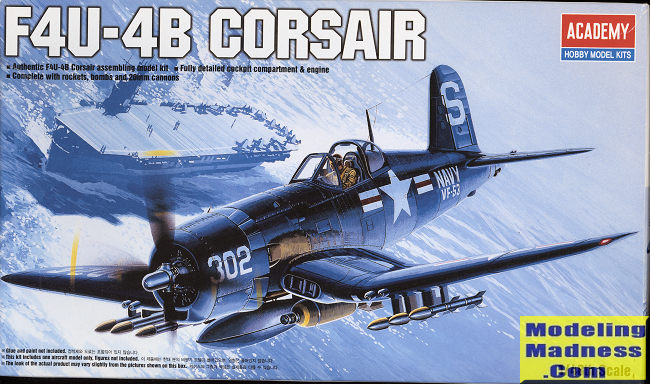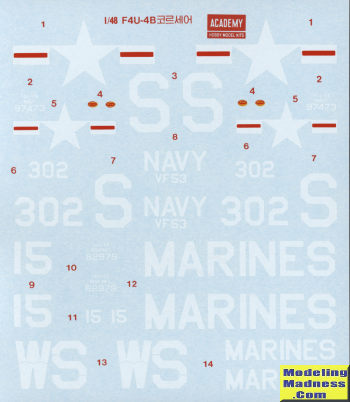
| KIT #: | 2124 |
| PRICE: | $16.98 |
| DECALS: | Two options |
| REVIEWER: | Scott Van Aken |
| NOTES: | 1993 release |

| HISTORY |
During the Korean War, the Corsair was used mostly in the close-support role. The AU-1 Corsair was developed from the F4U-5 and was a ground-attack version which normally operated at low altitudes: as a consequence the Pratt & Whitney R-2800-83W engine used a single-stage, manually controlled supercharger, rather than the two-stage automatic supercharger of the -5. The versions of the Corsair used in Korea from 1950 to 1953 were the AU-1, F4U-4B, -4P and -5N and 5-NL. There were dogfights between F4Us and Soviet-built Yakovlev Yak-9 fighters early in the war, but when the enemy introduced the Mikoyan-Gurevich MiG-15, the Corsair was outmatched: on 10 September 1952, a MiG-15 made the mistake of getting into a turning contest with a Corsair piloted by Marine pilot Captain Jesse G. Folmar, with Folmar shooting the MiG down with his four 20 mm cannon. In turn, four MiG-15s shot down Folmar minutes later; Folmar bailed out and was quickly rescued with little injury.
| THE KIT |
 Korean
War era Corsair kits are not exactly falling off the trees, but in 1/48, the
major variants are covered with Hasegawa doing the -5 versions and the -4
variant (which I think is a Mania kit). To my knowledge, only Academy has
produced the cannon armed -4B.
Korean
War era Corsair kits are not exactly falling off the trees, but in 1/48, the
major variants are covered with Hasegawa doing the -5 versions and the -4
variant (which I think is a Mania kit). To my knowledge, only Academy has
produced the cannon armed -4B.
Its release in 1993 was well received, though I seem to vaguely recall the usual fuss about something being inaccurate. Perhaps it was in reference to the 'hills and valleys' of the outer wing sections. I'm sure a reader will enlighten me. Anyway, the detailing is engraved and looks to be well done and crisp. The kit does not have inserts as Academy never did any other variations.
The cockpit is fairly basic with raised detail on the instrument panel and side consoles. No rudder pedals, but a stick seat and aft bulkhead. There is no interior sidewall detail. The kit's engine is half of the forward banks on a blanking plate with a separate forward section that includes the pushrods and the prop gearbox. The forward cowling is a single piece so no worries on filling a lip.
Landing gear is nicely detailed for this scale and while the gear wells may not be up to some specs, the forward ones have some detail in them though the rear is just a blank plate. The rear gear is two pieces with the tail hook and wheel molded into the gear itself. Gear doors fit into slots in the main and tail gear wells. There are small fairings that need to be added to the tail doors.
The lower wing has slots for the coolant radiators and one
needs to open holes for the rockets. Bomb racks are molded in place. Apparently,
one of the rocket stubs is molded onto the outer gun barrel. This results in
having one rocket proud of the others. There are eight rockets. You also get a
pair of bombs or drop tanks for the molded on racks. I am sure that those
Corsairs operating out of the Pusan perimiter would have had a full load as
their flight time to the front lines would have been short.

The kit provides separate windscreen and canopy so you can perhaps pose it open though it is shown closed. A single piece prop fits on the prop shaft and it can turn assuming you didn't overdo the cement when attaching the forward engine piece.
Instructions are well done with generic color information. Basically the two options are overall gloss sea blue with 'khaki green' used for most of the cockpit and the gear wells/doors. To be honest, I would think that the gear wells/doors would be sea blue as well. I looked at a lot of period photos, and couldn't really see anything that would indicate either way, but all the wing fold areas and usually gear legs were sea blue so one could easily assume the wells would be the same. Markings are for two planes. The box art plane is from VF-53 while the other option is a VMF-323 plane with no really unique markings aside from the tail code. Decals look to be well printed, and I'm sure you can find aftermarket if the kit options do not appeal.
| CONCLUSIONS |
This is the sort of kit that most modelers will like. It certainly does not appear to be a fussy build and has more than enough detail to satisfy most builders. I'd add a harness for the seat and pretty much leave the rest as is.
| REFERENCES |
https://en.wikipedia.org/wiki/Vought_F4U_Corsair
October 2017
Copyright ModelingMadness.com. All rights reserved. If you would like your product reviewed fairly and
fairly quickly, please
contact
the editor or see other details in the
Note to
Contributors. Back to the Main Page
Back to the Review
Index Page
Back to the Previews Index Page